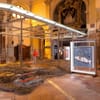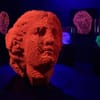A new report by Serpentine Gallery's Arts Technologies team challenges the UK government to rethink what counts as innovation, arguing that artists play a much bigger role in shaping technology than policymakers often realise.
The briefing, Future Art Ecosystems 5: Art x Creative R&D (FAE5), has been released just as the government works on its Industrial Strategy. The timing isn’t accidental: the authors want to make sure art isn’t sidelined in discussions about the country’s technological future.
At the core of the report is Creative Research & Development (R&D) at the intersection of art and advanced technologies (AxAT).
it's a space where artists experiment with technology in ways that don’t fit neatly into the commercial or academic boxes. Instead, these projects often cross sectors, link cultural institutions with universities and tech firms, and raise questions about how technology could evolve differently.
In this context, artists aren’t just making work for galleries. They act as translators, connectors and even inventors. As artist Wendi Yan puts it: "What interests me isn’t simply visualising scientific data or using technology for its own sake, but asking what other kinds of knowledge might be possible."
The report highlights three big contributions artists are making:
Opening up public conversations
By turning emerging technologies into something people can understand and debate, artists bring wider communities into discussions that are usually closed off. Alice Bucknell explains: "It’s about taking research that’s still in that gooey R&D stage and turning it into a public conversation."
Imagining alternative futures
Artists often raise possibilities that conventional research overlooks. As Lauren Lee McCarthy says: "For anything to become possible, it first has to be imagined."
Building tools and systems
Some artists don’t just imagine, they create. McCarthy also developed p5.js, an open-source library that’s opened up creative coding to millions. Ian Cheng has proposed rethinking AI not as a personal assistant but as a bridge between people: "AI is really good at being this emissary, this bridge. That kind of reframing is something I took from art into the startup world."
But the report also points to barriers. Funding systems and institutions often don’t see this kind of work as research, forcing artists to present it as exhibitions or “public engagement” instead. Artist Alexandra Daisy Ginsberg reflects: "It feels odd to describe my practice as R&D, but I am a researcher. My work holds research questions, even if it looks like art."
To fix this, FAE5 lays out several proposals: creating a government body dedicated to Creative R&D, widening the definition of R&D to include creative work, finding new ways to measure cultural and technological value, and diversifying funding streams.
The printed Future Art Ecosystems 5: Art x Creative R&D book is now available for pre-order, featuring insights from over 60 contributors including Danielle Brathwaite-Shirley, Anicka Yi, Lauren Lee McCarthy, Natsai Audrey Chieza, Ian Cheng and many more.





